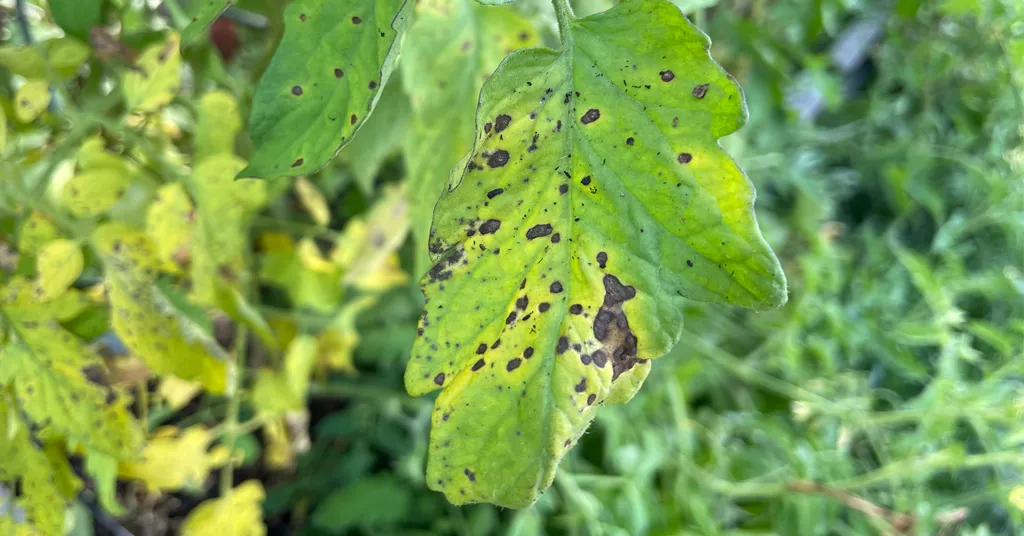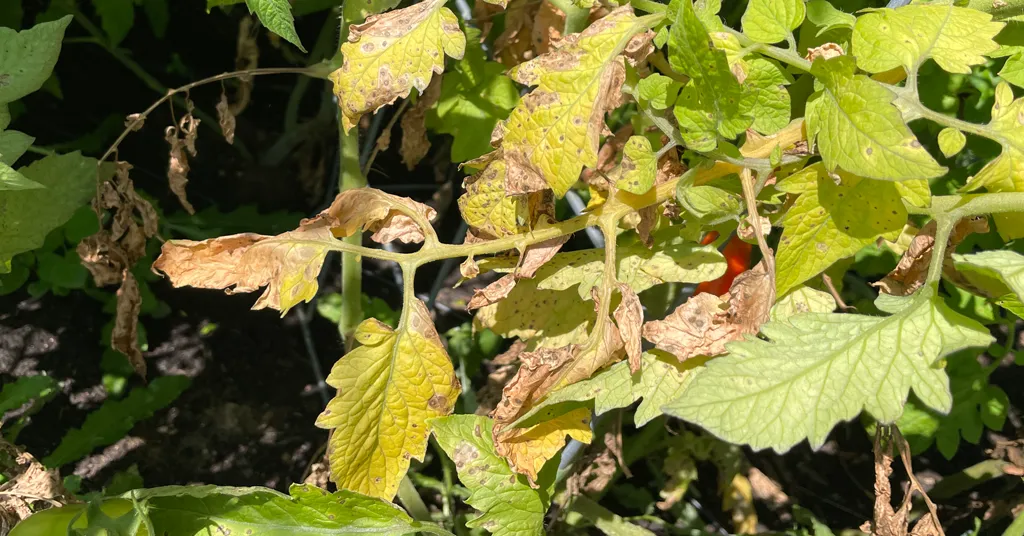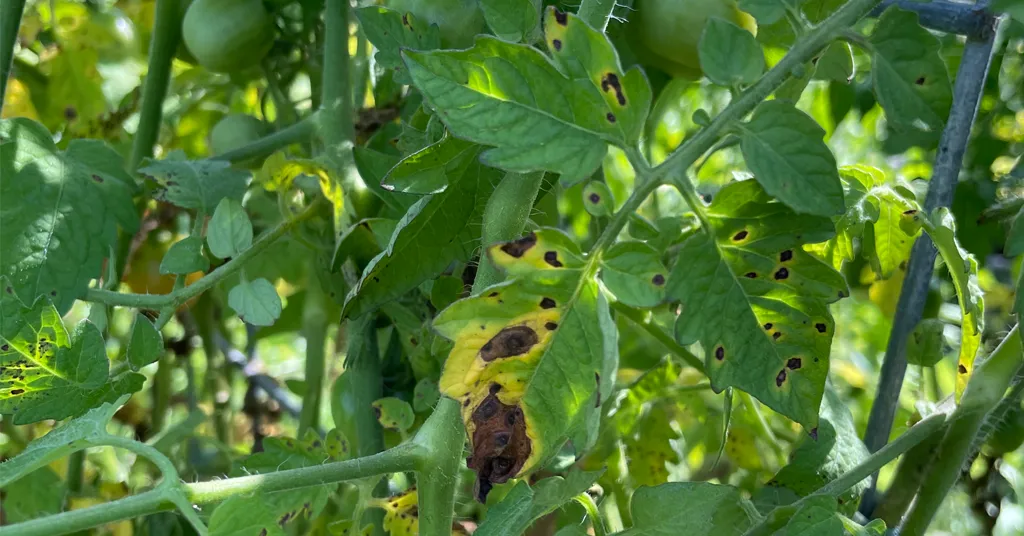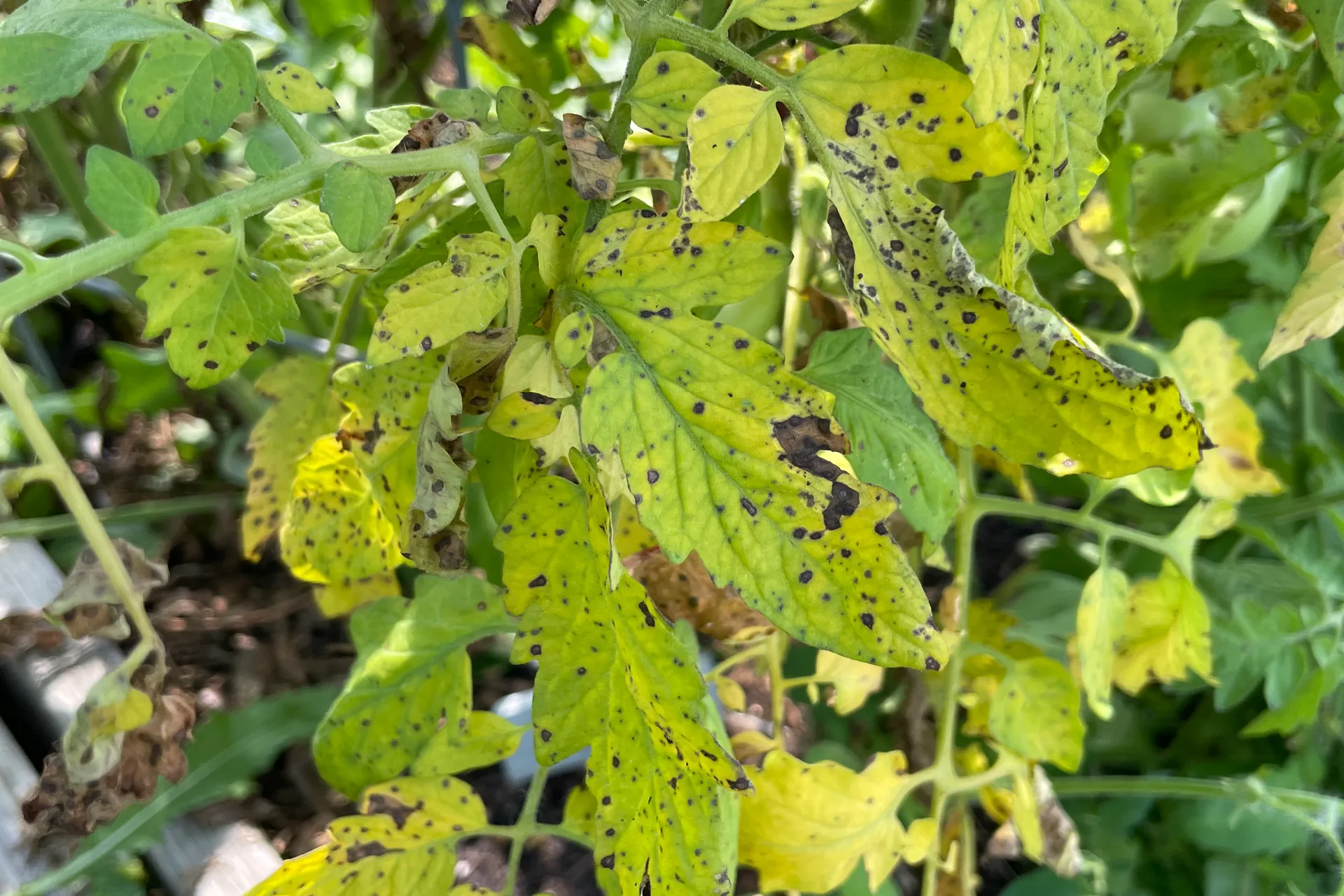This post may contain affiliate links. When you purchase through links on my site, I may earn a commission at no cost to you. See my Privacy Policy for details.
Tomato plants are a popular choice for gardeners due to their versatility and delicious fruit. However, they are susceptible to various diseases, and one of the most common problems they face is Early Blight, caused by the fungus Alternaria solani. Let’s talk about what it is, identification, prevention, and management of Early Blight to help protect your tomato plants and ensure a successful harvest.
What is Early Blight?
Early Blight is a fungal disease that primarily affects tomato plants, though it can also affect other solanaceous crops like potatoes. It is caused by the pathogen Alternaria solani, and it usually starts to manifest during the early to mid-growing season. The disease manifests as small, dark spots with concentric rings on the lower leaves of the plant. As the infection progresses, these spots gradually enlarge and merge, leading to widespread leaf yellowing, browning, and defoliation. If left unchecked, Early Blight can significantly reduce tomato yields and weaken the overall health of the plant.

Early Blight Pathogen and Disease Cycle
The fungus Alternaria solani overwinters in infected plant debris left in the soil from previous growing seasons. During the early spring, under favorable environmental conditions, the pathogen becomes active and starts producing spores. These spores are released into the air and can travel short distances to reach nearby tomato plants.
Early Symptoms of Early Blight
Early Blight typically starts to manifest during the early to mid-growing season, usually when the weather is warm and humid. The first signs of the disease appear as small, circular or irregular-shaped spots on the lower leaves of the tomato plant. These spots often have a dark brown or black coloration and may have a target-like appearance with concentric rings, which aids in its identification.
As the infection progresses, the small spots gradually increase in size and coalesce into larger lesions. These expanding lesions can measure anywhere from a few millimeters to several centimeters in diameter. The center of the lesions may dry out and become papery, while the edges remain actively growing and continue to spread.
Tomato Leaf Yellowing and Browning
With the growth and enlargement of the lesions, the affected leaves begin to exhibit yellowing around the lesions. The yellowing may gradually spread beyond the lesion, causing more extensive areas of discoloration on the leaves. As the disease advances, the yellowed areas turn brown and eventually necrotic, leading to defoliation of the lower leaves.

Tomato Stem and Fruit Infection
While Early Blight primarily affects the foliage, it can also spread to the stems and fruits of the tomato plant. Infected stems may develop dark brown to black lesions, leading to reduced stem strength and possible wilting of the plant. Fruits, especially those in close contact with infected foliage, may develop sunken, dark lesions that render them unmarketable and unpalatable.
Impact on Tomato Plant Health and Yield
Early Blight can significantly weaken the overall health of the tomato plant. As the disease progresses, the plant loses its ability to perform photosynthesis effectively, resulting in reduced vigor and poor growth. Severe defoliation can lead to sunscald on fruits due to increased exposure to sunlight. Additionally, the plant’s weakened state makes it more susceptible to other pathogens and environmental stresses, further compromising its yield potential.
Early Blight Prevention and Management
As a gardener, understanding effective prevention and management strategies is paramount to safeguarding your precious tomato crops and ensuring their optimal health and productivity. By implementing proactive measures and employing best practices, you can create an inhospitable environment for the Early Blight pathogen and mitigate its devastating effects. Let’s explore a range of preventive techniques and practical management approaches that will empower you to combat Early Blight and foster thriving, disease-resistant tomato plants.

Adequate Tomato Plant Spacing and Air Circulation
Proper spacing between tomato plants is essential to promote good air circulation. When plants are too close together, the humidity levels rise, creating a favorable environment for the development and spread of fungal diseases like Early Blight. By providing adequate space between plants, you reduce the chances of infection and help keep your plants healthier.
Avoid Overhead Watering
Moisture plays a critical role in the spread of Early Blight. To minimize humidity around the plants, avoid overhead watering whenever possible. Instead, opt for methods like drip irrigation or soaker hoses that deliver water directly to the soil, keeping the foliage dry. Watering early in the day also allows excess moisture to evaporate before evening, further reducing the risk of fungal growth.
Fungicides
Applying fungicides early in the season, as a preventive measure, can be effective in controlling Early Blight. There are various fungicides available, but be sure to choose ones specifically formulated for tomatoes and approved for use in your region. Follow the instructions provided on the product label for proper application and safety guidelines.
Crop Rotation
Avoid planting tomatoes or any other solanaceous crops in the same location year after year. Crop rotation is a fundamental practice in gardening that helps break the disease cycle. Alternating the location of tomato plants each season can significantly reduce the risk of Early Blight and other soil-borne diseases.
Pruning and Sanitation
Regularly prune off affected leaves and remove any fallen plant debris from the vicinity. By doing so, you prevent the disease from spreading to healthy parts of the plant and minimize the chances of the fungus overwintering and recurring in subsequent seasons.
Early Blight
Early Blight poses a significant threat to tomato plants and can hamper their growth and productivity if left unchecked. However, armed with the knowledge of its early symptoms, disease cycle, and impact on tomato health, you can take proactive steps to prevent and manage this fungal menace.
By adhering to proper practices such as spacing plants adequately, avoiding overhead watering, and implementing crop rotation, you create an unfavorable environment for the Early Blight pathogen to thrive. Timely application of fungicides as a preventive measure can further bolster your plants’ defenses against this disease.
Remember, vigilance is key in keeping Early Blight at bay. Regularly inspect your tomato plants for any signs of infection, and promptly prune and dispose of affected leaves to prevent the disease from spreading. Maintaining good garden hygiene, including removing plant debris, also aids in reducing the pathogen’s presence.
By following the preventive and management strategies we discussed, you can protect your tomato plants from Early Blight and ensure a bountiful harvest of delicious, healthy fruits.
We hope this information has empowered you to safeguard your tomato crops effectively. For more valuable information on tomato care and other gardening tips, be sure to explore other articles on our blog. Happy gardening!

